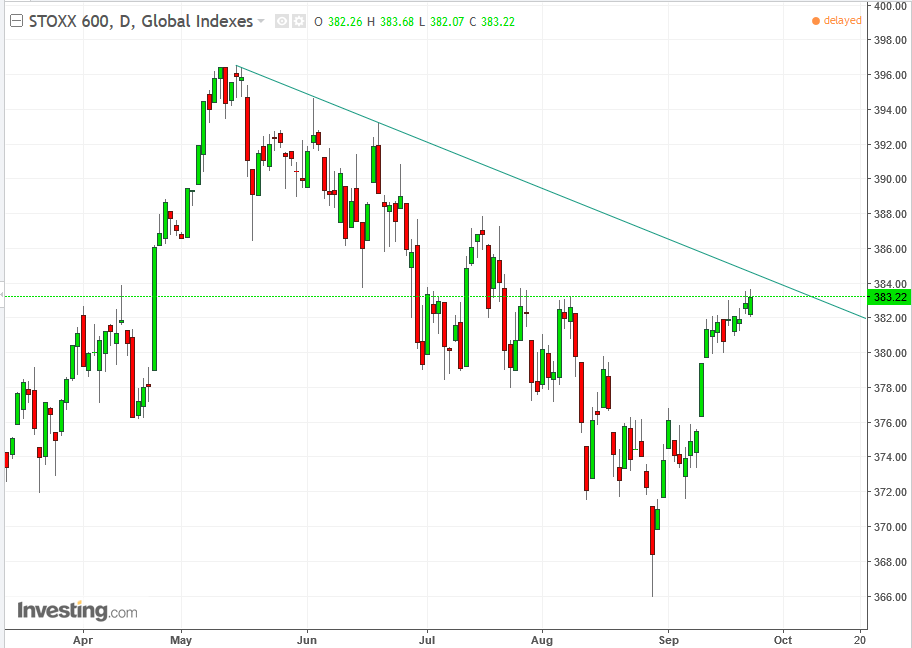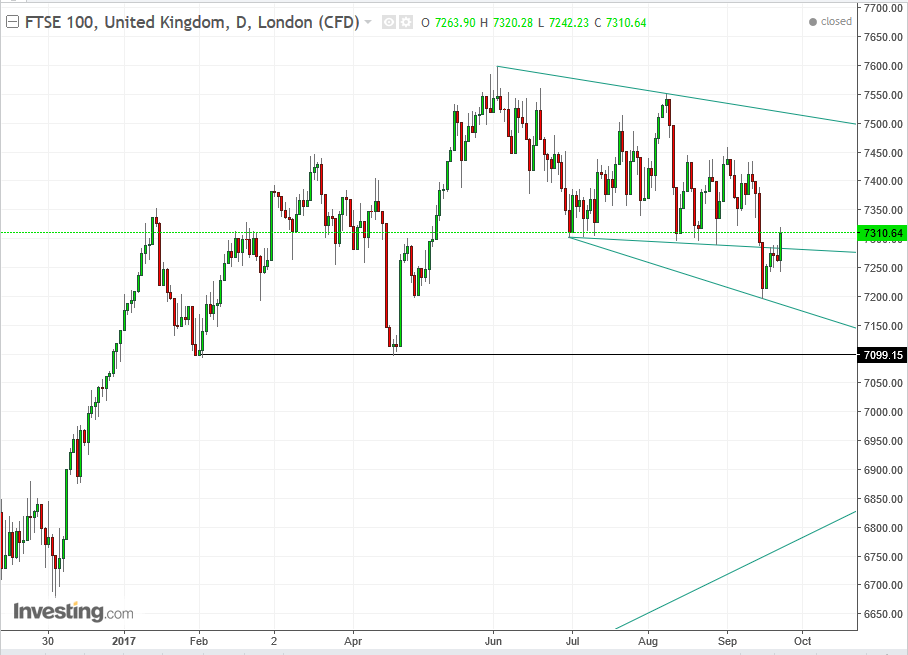by Pinchas Cohen
The Week That Was
Fed: Predictable, Unpredictable
The most highly anticipated event of the month, the Fed policy meeting this past Wednesday, played out as expected. However, it ushers in a period of uncertainty for the stock market.
As anticipated, the Federal Open Market Committee kept rates unchanged, while suggesting a hike by year-end remains on the table. Policy makers projected three hikes in 2018 and two more in 2019.
As anticipated, the Fed announced that it will begin shrinking the $4.5 trillion in October, in installments of $10 billion a quarter, until it reaches $50 billion. What is uncertain, however, is how the market will react, after becoming accustomed to the lowest yearly volatility in 50 years, as the CBOE Volatility Index (VIX) has spent much of the year near all-time lows.
Though the Fed had already started raising rates in December 2015, albeit extremely slowly, the unloading of its $4.5 trillion in Treasuries and mortgage-backed securities may prove to be the opening shot that investors actually hear as the diminishing of post-crisis accommodation. If tightening cycles historically have led to a jump in stock market volatility, how would the tightening cycle that follows the highest accommodation in market history, that led to the least volatile market in 50 years, affect markets?
While consensus dictates that the Fed will be cautious about not shaking up all-time-high stock markets, as well as being careful to support reconstruction in the aftermath of two highly detrimental hurricanes, they may inadvertently generate a flash-crash prone environment, in which one shaky finger triggers a snowball effect that leads down a very slippery slope.
Speak Softly Or Carry a Big Stick
According to his supporters, US President Donald Trump is standing tough against North Korea's Kim Jong Un, a ruthless dictator. According to his opponents, Trump is playing chicken with a madman.
Said opponents keep vociferously repeating Teddy Roosevelt’s famous maxim: 'Speak softly and carry a big stick.' Who wants to go to war with North Korea, they ask? The President’s supporters’ counter-argument would be: that’s what the big stick is for. Otherwise, all you end up doing is just speaking softly, a not-so-subtle reference to former US President Barak Obama.
Whatever one’s politics, geopolitical risks may loom large, but so far equity investors have managed not to be cowed. “Past results are not indicative of future returns” is a generic disclaimer on investment accounts, and its logic is just as applicable here.
Indifference by equity investors to geopolitical risk may suggest that they know not to get too excited by sabre rattling. However, it could also mean that the very extreme highs investors have been enjoying could soon reach a breaking point.
China Leadership Shifting to Europe?
Back at the end of May, after the downgrade to China’s credit rating, we made the case that we might be at the cusp of an economic leadership change, in which Europe will usurp the position of world economic leader. On Thursday, Standard and Poor’s downgraded China’s long-term sovereign credit rating from AA- to A+. The rating agency sees China’s credit as having grown out of hand, increasing the country’s financial risks for the next couple of years. Similarly, S&P reduced China’s short-term rating from A-1+ to A-1.
US Existing Home Sales: 12-Month Low
US existing home sales dropped 1.7 percent to 5.35 million units in August, the lowest since August 2016. However, a 25-percent, razor-sharp plunge in home sales in Houston—compared to last year—a direct result of Hurricane Harvey, accounts for most of the decline. The South experienced a 5.7-percent decline. Home sales are expected to continue to suffer from Harvey, but unless something unexpected occurs, there is no reason to believe that the recent data represents a longer-term pattern.
Trump-Trade: Take 2
Republicans on a US Senate panel proposed a budget deal that would allow a $1.5 trillion tax cut over the next 10 years. While considered good news for stock prices, the tax cut would increase the $20 trillion Federal debt, already projected to increase to about $30 trillion over the next decade.
BOJ Keeps Policy in Check
Unlike the Fed, the BoJ is showing no signs of shifting out of its monetary stimulus.
The Week Ahead
All times are EDT
Monday
4:00: Germany – German IFO Index (September): business climate index expected to rise from 115.9 to 116.0

On August 29, the EUR/USD reached the top of the channel in which the pair has been trading since April, which set it on a corrective path. Getting in at 1.1900 would provide an ideal long entry, both in terms of support as well as risk-reward, between the September 14, 1.1837 low to the September 8, 1.2016 high.
Tuesday
10:00: US – Consumer Confidence (September), New Home Sales (August): confidence projected to decline from 122.9 to 120.0, and new homes sales are seen to have risen from 571K to an annual rate of 580K.

Since March, the S&P 500 has been trading within a rising channel in which buyers have steadily overtaken sellers. This past Wednesday, the bears gave it a go, after the benchmark registered its 42nd record high of the year.
However, after erasing nearly 3 days of gains, the bulls reestablished control and closed on a record. Trading produced a Hanging Man, which in itself is a bullish formation that demonstrates bulls' control. On Thursday, the price fell, erasing two days of gains. This was a bucket of cold water dumped on bullish complacency. Indeed, bulls were stopped out by this unexpected turn of events.
Gains on Friday—even after the index gapped down on the latest round of US-North Korean tensions, as well as the strengthening of safe havens such as Treasuries and the yen—may turn out to be short covering, providing an attractive short-entry point.
Wednesday
8:30: US – Durable Goods Orders (August): orders predicted to rise 1.5% from a 6.8% drop a month earlier. Excluding transportation, the figures are 0.3% from 0.5%. 15:00: US – Pending Home Sales (August): sales forecast to fall 1% from 1.3%. Markets to watch: US indices, USD crosses

The US Dollar Index has rebounded from its 91.00 multi-year low, and has been consolidating since in what may prove to be a bottom. However, for now, it is still within a downtrend. A rise to 92.5 may be a shorting opportunity to the range bottom of 91.60 and perhaps to retest the 91.00 low.
10:30: US – EIA Crude Inventories (w/e 22 Sept): previous week’s figure was a rise of 4.591 million barrels.

While the price of oil does appear to have reversed its downtrend from February into an uptrend since June, this was seen as such only since it crossed above the falling channel and registered a peak higher than its former peak in August, the price has been experiencing significant selling resistance at the $50 level. It may retest the new, rising channels’ support, toward $47.
Thursday
5:00: Eurozone – Business Confidence (September): forecast to rise from 1 to 1.1.
8:00: Germany – CPI (September, preliminary): expected to hold at 1.8%.

The STOXX 600 Index has neared its downtrend line since May.
8:30: US – GDP (Q2, final), Initial Jobless Claims (w/e 23 September): GDP expected to be left unrevised at 3.0% QoQ. Initial jobless claims expected to rise from 259K to 270K
19:30: Japan – Unemployment Rate (August): expected to rise from 2.8%. to 2.9%

The USD/JPY pair has produced a Bearish Engulfing Pattern near the top of its falling channel since March, suggesting a retesting of 107.00.
Friday
4:00: Germany – Unemployment Rate (September): expected to remain at 5.7%. Market to watch: eurozone indices, EUR crosses
4:40: UK – GDP (Q2, final): no change to previous estimates of 0.3% QoQ and 1.7% YoY expected.

The UK's FTSE 100 Index is struggling on the line that meets a series of lows starting at June 30. However, having registered a lower peak on September 15 suggests a downtrend, at least till it meets its long-term uptrend line, currently at 6850, and rising. The 7100 level is expected to provide a support, after it has done so in February and April.
5:00: Eurozone – Inflation (September, flash): overall CPI expected to fall from 1.5% to 1.4% YoY, while core CPI climbs from 1.2%. to 1.3%.
9:45 US – Chicago PMI (September): expected to fall from 58.9 to 58.2.
10:00: US – Michigan Consumer Confidence (September, final): no change to the 96.8 reading expected.
